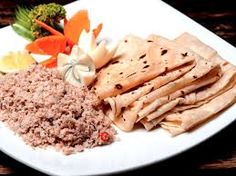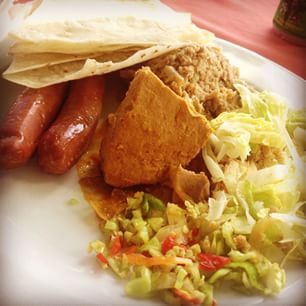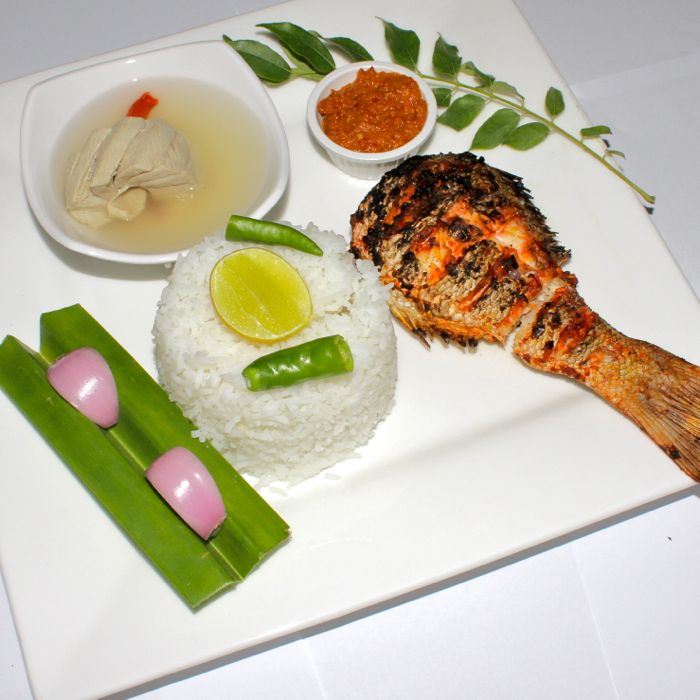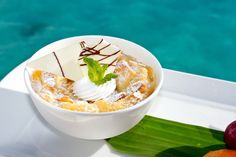Maldives is an island nation in the Indian Ocean–Arabian Sea area, consisting of a double chain of twenty-six atolls, oriented north-south, that lie between Minicoy Island (the southernmost part of Lakshadweep, India) and the Chagos Archipelago. The chains stand in the Laccadive Sea, and the capital, Male is about 600 kilometers (370 mi) south-west of India and 750 kilometers (470 mi) south-west of Sri Lanka.
The Maldives has a tropical-monsoon climate, which is affected by the large landmass of South Asia to the north. The presence of this landmass causes differential heating of land and water. These factors set off a rush of moisture-rich air from the Indian Ocean over South Asia, resulting in the southwest monsoon. Two seasons dominate Maldives' weather: the dry season associated with the winter northeastern monsoon and the rainy season which brings strong winds and storms.
The official and common language is Dhivehi, an Indo-Aryan language having some similarities with Elu, the ancient Sinhalese language. The first known script used to write Dhivehi is Eveyla akuru script which is found in historical recording of kings (raadhavalhi). Later a script called Dhives akuru was used for a long period. The present-day script is called Thaana and is written from right to left. Thaana is said to have been introduced by the reign of Mohamed Thakurufaanu. English is used widely in commerce and increasingly in government schools.
Maldives, officially the Republic of the Maldives and referred to as the Maldive Islands, is an island nation in the Indian Ocean-Arabian Sea region. The country is made up of 27 atolls between the Chagos Archipelago and Minicoy Island, 250 miles southwest of India. In 2014, Maldives has an estimated population of 394,000, which ranks 175th in the world.
After the long Buddhist period of Maldivian history, Muslim traders introduced Sunni Islam. Maldivians converted to Islam by the mid-12th century. The islands has had a long history of Sufic orders, as can be seen in the history of the country such as the building of tombs. They were used until as recently as the 1980s for seeking the help of buried Saints. They can be seen today next to some old mosques and are considered today as cultural heritage. Other aspects of tassawuf, such as ritualised dhikr ceremonies called Maulūdu (Mawlid)—the liturgy of which included recitations and certain supplications in a melodical tone—existed until very recent times. These Maulūdu festivals were held in ornate tents specially built for the occasion. At present Sunni Islam is the official religion of the entire population, as adherence to it is required for citizenship.
Traditional Maldivian cuisine is based on three main items and their derivatives: coconuts, fish and starches.
The coconut is used in the grated form, squeezed to obtain coconut milk, or as coconut oil in dishes that are deep-fried. The hunigondi is the traditional Maldivian implement used to grate the coconut. It is a long low chair with a serrated steel blade at its end. Grated coconut is used in dishes such as mas huni.
The grated coconut may be alternatively soaked in water and squeezed in order to obtain coconut milk (kaashi kiru). Coconut milk is an essential ingredient in many Maldivian curries and other dishes.
The favourite fish is skipjack tuna, either dried or fresh. Other similar fish species that are part of the average Maldivian diet are little tunny(latti), yellowfin tuna (kanneli), frigate tuna (raagondi), bigeye scad (mushimas), wahoo (kurumas), Mahi-mahi (fiyala) and Mackerel scad(rimmas). These can be eaten boiled or processed.
Processed tuna (Maldive fish) is used as pieces or as shavings. In order to make curries, the raw or the still-soft processed tuna is cut into1⁄2-inch-thick (13 mm) sections. Dry processed tuna is mainly used to make short eats called gulha, masroshi, kulhi bōkiba, kavaabu,bajiya (the local version of the Indian samosa), and fatafolhi. Unlike Pacific islanders, Maldivians don't have the tradition of eating raw fish.
1. Mas huni’ (tuna and coconut mix) :

Mas huni’ is a blend of tuna, coconut and chili, which is loved by all Maldivians. It is more like a salad and requires very little time to prepare. This dish is eaten for breakfast with ‘roshi’ or chapatti and black tea.
2. Kulhimas’ (chili tuna):

Kulhi’ in Dhivehi, means hot or spicy and ‘mas’ means fish. Every single Maldivian enjoys this dish. It is easy to prepare and simply delicious. This dish can be eaten for breakfast with ‘roshi‘ or chapatti, or for dinner with ‘roshi’ or rice.
3. Garudhiya’ (Maldivian fish soup) :

From time in memorial, Maldivians have been fishing and drying or smoking tuna. The fishes that have been smoked are used to make dishes like ‘mas huni’. Raw tuna is used to prepare ‘garudhiya’. This dish is highly valued and eaten by Maldivians almost every day.
4.Handulu Bondibai’ (sweetened sticky rice):

A special dessert made by the people of Maldives for the most special occasions like the birth of a child. This dish is eaten with ‘kulhimas’ or separately. 'Bondibai' is commonly prepared with rice; but it can also be made using sago or breadfruit. On special occasions, parcels of ‘Kulhimas’ and ‘bondibai’ are distributed to all households in the islands.
5. Kulhi boakibaa’ (fish cake) :

For hundreds and probably thousands of years, ‘kulhiboakibaa’ or fish cake has been a very special food for the Maldivians. It is made especially for occasions like festivals and feasts. Nowadays the fish cake is also eaten as a short-eat during evening tea.
1-Diving:
The warm seas of Maldives have high visibility throughout the year; with water clear enough to see the passing fish as far as fifty meters away at times. Add to that the marvelous formation of over 3000 coral reefs and the free flowing tides of the monsoons. The result of these perfect conditions has created one of the world’s richest diving coral reef areas.
2-Surfing:
Maldives is a Mecca to surf-enthusiasts from all over the world, with the southwest monsoon bringing with it massive swells, especially from June to September. The sizes range from 3 – 8 feet. There are several well-known surf breaks in North and South Male’ Atoll. Resorts near these breaks are perfect for surfing aficionados, as you can get the full Maldivian experience while riding the waves to your heart’s content. The lesser-known, but amazing surf breaks further away from Male’ atoll can be accessed by specialized surf cruises (often referred to as surfaries) offered by cruise operators in the country.
3-Night fishing:
Fishing is in the Maldivian blood. It is so entwined in the lives of Maldivians that there are celebrations when a good catch is caught and complaints when fish is scarce at our dinner tables. Maldivian fishermen wake up to the dawn call of island roosters, collect bait in nearby reefs and start a full day’s work at the deep blue seas, using the artful pole and line method of fishing.
4-Spa and wellness:
Just lying on a deserted beach of a Maldivian island, taking in nothing but the continuous rhythm of the waves, the sea salt in the air and feeling the soft white sand on your bare feet is enough to sooth your senses. Each island with its green vegetation and secluded setting is a natural spa in its own right, designed to soothe, caress, and heal. Spas set in the Maldives, thus, are perfected as the ultimate getaway cocoons in the middle of the vast Indian Ocean. Traditional healing methods, that have been passed on for generations as family secrets by the hakeembe (healing experts), have been incorporated into special spa programs in the Maldivian islands. The types of treatments vary with each spa but you can get almost any world-class treatment in a Maldivian spa. Every Maldivian resort has a spa; some of them nestled deep within thick vegetation, others sitting in solitude on a wooden jetty built on the lagoon, and some even built underwater. Maldivian virgin coconut oil produced using age-old extraction techniques which is known among islanders for its hydrating and healthful elements is now used in some resort spas, as is the local favorite gandhakolhi leaf which is blended to treat almost any minor ache, and the traditional Maldivian sand massage used by islanders to cure muscle and joint pains.
5-Snorkeling:
For those who would love to see the underwater but hesitate to take the deep plunge, snorkeling is a wonderful alternative. Since the lagoons of Maldives are so clear that with just a snorkel mask and fin you can be witness to the activities of the many different species of fish and fauna on the unique Maldivian reefs. You are guaranteed to encounter playful fish and rare corals even on the resorts’ house reefs and perhaps a turtle or some other curious creatures too if you are lucky.
6-Island Hopping:
An ‘island-hopping’ excursion would take you to another resort, an uninhabited island and an inhabited island all in a day-tour designed to give you a taste of the country.You would also get the opportunity to snorkel in the clear waters of a desert island and experience a barbecue on the beach. Some resorts take this a step further by conducting the excursion by sea plane.
Male’ is most famous for its motorbikes, the fastest way to get around. Taxis are easily available and you will be charged Rufiyaa 20 for each trip, no matter where you go in Male’. You could always take the easier option and walk: anywhere in Male’ is reachable in ten minutes.
05 Stars:
The hotel offers a snack bar/deli. A bar/lounge is on site where guests can unwind with a drink. Guests can enjoy a complimentary breakfast. An Internet point is located on site and high-speed wireless Internet access is complimentary.
17B Obour Bldgs, Salah Salem Rd., Heliopolis, Cairo, Egypt
marketing@canyon.travel
operation@canyon.travel
02-22 62 50 54/44